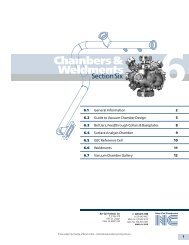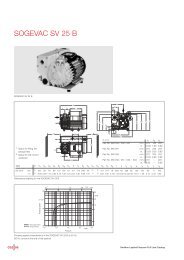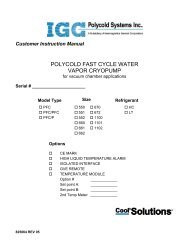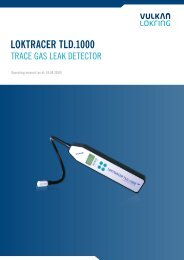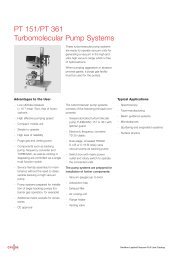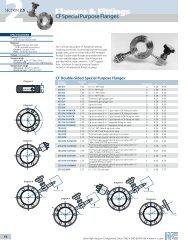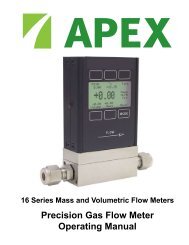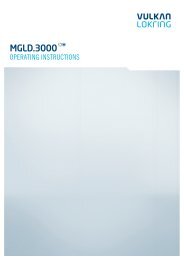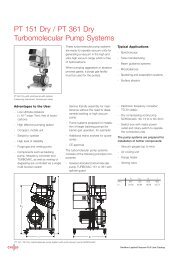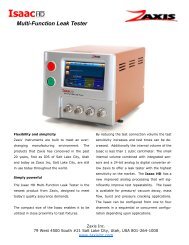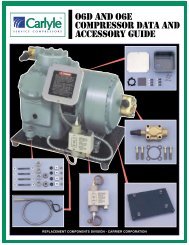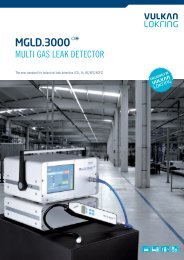INFICON CATALOG 2000-2001 - Schoonover, Inc.
INFICON CATALOG 2000-2001 - Schoonover, Inc.
INFICON CATALOG 2000-2001 - Schoonover, Inc.
Create successful ePaper yourself
Turn your PDF publications into a flip-book with our unique Google optimized e-Paper software.
Basic Terms of Vacuum Metrology<br />
Vacuum Gauges<br />
Basic Terms of Vacuum Metrology<br />
Today, the total range of measurable vacuum pressure extends from<br />
atmospheric pressure (about 1000 mbar, 750 Torr) down to 10 -12 mbar<br />
(Torr) Ð over 15 decades. The instruments used for measuring pressure<br />
within this wide range are called vacuum gauges. It is impossible to create<br />
a single vacuum sensor capable of performing quantitative measurements<br />
throughout the entire pressure range. Therefore, a variety of different<br />
vacuum gauges are available, each with its own characteristic<br />
measurement range, commonly extending over several decades.<br />
Note the difference between direct and indirect pressure measurements.<br />
With direct pressure measurements, vacuum gauge readings are<br />
independent of gas type. Vacuum gauges, in which pressure is<br />
determined directly by recording the force acting on the surface of a<br />
diaphragm, are common.<br />
With indirect pressure measurements, pressure is determined as a function<br />
of a pressure-dependent property of the gas (i.e. thermal conductivity or<br />
resulting ion current). These properties not only depend on pressure, but<br />
also on the molar mass of the gases. Therefore, vacuum gauge presssure<br />
readings relying on indirect pressure measurements are gas composition<br />
dependent. These readings usually relate to air or nitrogen as the<br />
measurement gas. Appropriate correction factors must be applied for the<br />
measurement of other gases or vapors.<br />
Vacuum Gauges with Pressure Readings<br />
Independent of the Type of Gas<br />
Capacitance Diaphragm Vacuum Gauges<br />
A capacitance diaphragm gauge has two chambers. One is connected to<br />
the vacuum to be measured; the other holds a certain reference vacuum.<br />
The chambers are separated through a metal coated ceramic or thin metal<br />
membrane. Together with a parallel electrode this membrane functions as a<br />
condensator. When the pressure in one chamber is different from the<br />
pressure in the other chamber the membrane bends and thus changes the<br />
capacitance. The change is registered and converted into a pressure signal,<br />
a voltage proportional to the pressure. This method makes gas type<br />
independent absolute pressure measurement possible. Absolute capacitance<br />
gauges can accurately measure pressures from 10 -5 mbar (Torr) to well above<br />
atmospheric pressure using capacitance gauges having diaphragms of<br />
different thickness. 1)<br />
<strong>INFICON</strong> improvements in materials composition provide more stable and<br />
reliable measurements over an extended period of operation. At the same<br />
time, corrosion resistance is greatly enhanced by using ceramic instead<br />
of metal.<br />
Vacuum Gauges with Pressure Readings<br />
Depending on the Type of Gas<br />
Thermal Conductivity Vacuum Gauges (Pirani)<br />
The energy transfer from a hot wire by a gas can be used to measure the<br />
pressure. The heat is transferred into the gas by molecular collisions with<br />
the wire, i.e. by heat conduction and the rate at which the heat is<br />
transferred depends on the thermal conductivity of the gas.<br />
The heat loss from a wire (typically 5 µm to 20 µm in diameter) can be<br />
determined indirectly with a Wheatstone bridge circuit which both heats the<br />
wire and measures its resistance and therefore its temperature.<br />
A thin metal wire is suspended with at least one side electrically insulated<br />
in the gauge head and is exposed to the gas. Tungsten, nickel, iridium or<br />
platinum may be used for the wire. The wire is electrically heated and the<br />
heat transfer is electronically measured. There are three common operating<br />
methods: constant temperature method, constant voltage bridge, and the<br />
constant current bridge. All these methods indirectly measure the<br />
temperature of the wire by its resistance.<br />
This measurement principle uses the thermal conductivity of gases for<br />
pressure measurements from 10 -4 mbar (Torr) to atmospheric pressure.<br />
<strong>INFICON</strong> improvements in temperature compensation provide stable<br />
pressure readings in spite of large temperature changes, especially when<br />
measuring low pressures.<br />
Ionization Gauges<br />
When the pressure in a vacuum system is below about 10 -4 mbar (Torr),<br />
direct methods of measurement of the pressure by means such as the<br />
deflection of a diaphragm or measurement of bulk gas properties such as<br />
thermal conductivity are no longer readily applicable. Hence, it is necessary<br />
to resort to methods which essentially count the number of gas molecules<br />
present i.e., it is the number density not the pressure which is measured.<br />
One of the most convenient methods to measure the number density is to<br />
use some technique to ionize the gas molecules and then collect the ions.<br />
The resulting ion current is directly related to pressure and a calibration can<br />
be performed. The probability of ionizing a gas molecule will depend on a<br />
variety of factors and hence, the ionization gauge will have different<br />
sensitivity values for different gas species.<br />
B6<br />
1) For p < 1 mbar and T Gauge T Vacuum the linearity of a gauge with a controlled temperature is<br />
influenced by the thermal transpiration (gas type dependent) at the maximum in the same order<br />
of magnitude as the zero point stability. See K. F. Poulter, et al., Vacuum 33, 331 (1983);<br />
W. Jitschin and P. Ršhl, J. Vac. Sci. Technol. A, Vol. 5, No. 3, 1987.<br />
B6.3



